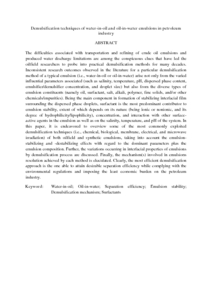Citation
Zolfaghari, Reza and Fakhru’l-Razi, Ahmadun and Abdullah, Luqman C. and Elnashaie, Said S. E. H. and Pendashteh, Alireza
(2016)
Demulsification techniques of water-in-oil and oil-in-water emulsions in petroleum industry.
Separation and Purification Technology, 170.
pp. 377-407.
ISSN 1383-5866; ESSN: 1873-3794
Abstract
The difficulties associated with transportation and refining of crude oil emulsions and produced water discharge limitations are among the conspicuous clues that have led the oilfield researchers to probe into practical demulsification methods for many decades. Inconsistent research outcomes observed in the literature for a particular demulsification method of a typical emulsion (i.e., water-in-oil or oil-in-water) arise not only from the varied influential parameters associated (such as salinity, temperature, pH, dispersed phase content, emulsifier/demulsifier concentration, and droplet size) but also from the diverse types of emulsion constituents (namely oil, surfactant, salt, alkali, polymer, fine solids, and/or other chemicals/impurities). Being the main component in formation of stabilizing interfacial film surrounding the dispersed phase droplets, surfactant is the most predominant contributor to emulsion stability, extent of which depends on its nature (being ionic or nonionic, and its degree of hydrophilicity/lipophilicity), concentration, and interaction with other surface-active agents in the emulsion as well as on the salinity, temperature, and pH of the system. In this paper, it is endeavored to overview some of the most commonly exploited demulsification techniques (i.e., chemical, biological, membrane, electrical, and microwave irradiation) of both oilfield and synthetic emulsions, taking into account the emulsion-stabilizing and -destabilizing effects with regard to the dominant parameters plus the emulsion composition. Further, the variations occurring in interfacial properties of emulsions by demulsification process are discussed. Finally, the mechanism(s) involved in emulsions resolution achieved by each method is elucidated. Clearly, the most efficient demulsification approach is the one able to attain desirable separation efficiency while complying with the environmental regulations and imposing the least economic burden on the petroleum industry.
Download File
![[img]](http://psasir.upm.edu.my/55437/1.hassmallThumbnailVersion/Demulsification%20techniques%20of%20water-in-oil%20and%20oil-in-water%20emulsions%20in%20petroleum%20.pdf)  Preview |
|
PDF (Abstract)
Demulsification techniques of water-in-oil and oil-in-water emulsions in petroleum .pdf
Download (86kB)
| Preview
|
|
Additional Metadata
Actions (login required)
 |
View Item |

